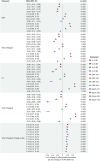The relationship between polyunsaturated fatty acids and inflammation: evidence from cohort and Mendelian randomization analyses
- PMID: 40550517
- PMCID: PMC12204398
- DOI: 10.1093/ije/dyaf065
The relationship between polyunsaturated fatty acids and inflammation: evidence from cohort and Mendelian randomization analyses
Abstract
Background: Omega-3 (n-3) and omega-6 (n-6) polyunsaturated fatty acids (PUFAs) are thought to have anti- and pro-inflammatory roles, respectively, and influence the risk of various chronic diseases. However, it is unclear whether these associations are causal.
Methods: We examined the associations of dietary polyunsaturated FAs with biomarkers of systemic inflammation: C-reactive protein (CRP), glycoprotein acetyls (GlycA), and interleukin 6 (IL-6) in two cohort datasets-Avon Longitudinal Study of Parents and Children (N = 2802) and UK Biobank (N = 12 401)-by using multivariable analyses. We investigated causality by using two-sample Mendelian randomization (MR). In addition to the inverse-variance weighted (IVW) method, we used sensitivity analyses to strengthen the causal inference. We conducted multivariable MR (MVMR) to investigate the causal effects of n-3 and n-6 on inflammation, accounting for the low-density lipoprotein (LDL) cholesterol, triglycerides, monounsaturated FAs, and saturated FAs.
Results: Cohort analyses show a positive association between the n-6:n-3 ratio and each biomarker. Total n-3 and n-6 PUFAs were associated with higher GlycA levels [mean difference = 0.33; 95% confidence interval (CI) = 0.29, 0.36, and 0.52; 95% CI = 0.48, 0.55, respectively]. The MR results suggest that total n-3 FAs cause higher circulating CRP (IVW = 0.09; 95% CI = 0.03, 0.16) and GlycA levels (0.12; 95% CI = 0.04, 0.21). The positive association between n-3 FAs and GlycA remained in the MVMR analysis after accounting for LDL cholesterol, triglycerides, monounsaturated FAs, and saturated FAs.
Conclusion: We find no convincing evidence of a simple pro- and anti-inflammatory dichotomy regarding the function of n-6 and n-3 PUFAs. Further research is needed to better understand the mechanisms underlying the effects of PUFAs on specific immune biomarkers.
Keywords: ALSPAC; CRP; ELOVL2; FADS; GlycA; IL-6; Mendelian randomization; biomarkers; inflammation; polyunsaturated fatty acids.
© The Author(s) 2025. Published by Oxford University Press on behalf of the International Epidemiological Association.
Figures






References
-
- El-Badry AM, Graf R, Clavien PA. Omega 3 - omega 6: what is right for the liver? J Hepatol 2007;47:718–25. - PubMed
MeSH terms
Substances
Grants and funding
LinkOut - more resources
Full Text Sources
Research Materials
Miscellaneous

